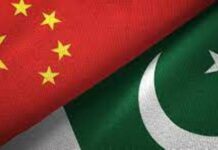
China’s 14th Five-Year Plan (2021-25) period will conclude this year. Zheng Shanjie, head of the National Development and Reform Commission (NDRC), the country’s top economic planner which coordinated the drafting of the plan, characterized the past five years as a period of “pioneering progress, transformative breakthroughs and historic achievements” at a July 9 press conference hosted by the State Council Information Office.
“China has become the most stable, reliable and dynamic force in global development,” he said.
Economic growth
Zheng said the estimated GDP increase during the 14th Five-Year Plan period exceeded 35 trillion yuan ($4.9 trillion), which equals the combined economic output of Guangdong, Jiangsu and Shandong provinces—China’s top three provincial economies, and surpasses the GDP of the world’s third largest economy. China has contributed 30 percent to global economic growth over the past five years, making it the world’s leading contributor. Over the first four years of the period, China’s economy expanded at an average annual growth rate of 5.5 percent, Zheng said.
Domestic demand has consistently been the primary driver of China’s economic development. In the past four years, domestic demand contributed an average of 86.4 percent of economic growth.
Zheng added that the real economy, the foundation of China’s national economy, is becoming increasingly robust. Since the start of the 14th Five-Year Plan period, the annual added value of manufacturing in China has exceeded 30 trillion yuan ($4 trillion), and the country has maintained its position as the world’s largest manufacturing base for 15 consecutive years. The output of over 200 major industrial products has ranked first worldwide every year for the past five years.

Groundbreaking innovation
The launch of China’s first domestically designed and built catapult-equipped aircraft carrier the Fujian in June 2022, the commercial operation of the world’s first fourth-generation nuclear power plant, the Shidaowan high-temperature gas-cooled reactor nuclear power plant in Weihai of Shandong Province, in December 2023, and the completion and operation of the first Chinese space station Tiangong in December 2022 are some of the major breakthroughs in innovation.
Yuan Da, Secretary General of the NDRC, said at the same press conference that during the 14th Five-Year Plan period, innovation has become the main driving force for promoting high-quality development.
The country’s total research and development (R&D) expenditure surged nearly 50 percent, or 1.2 trillion yuan ($167 billion), from 2020 to 2024, according to Zheng.
This increase in investment has led to an acceleration of key and core technology breakthroughs. In 2024, the annual output of integrated circuits increased by 72.6 percent, or 190 billion, from 2020, with more and more products now equipped with Chinese chips. New breakthroughs have been made in nuclear power, high-speed rail, and shipbuilding and marine engineering equipment, Yuan said.
The growth of emerging industries has accelerated. In 2024, the added value of China’s hi-tech manufacturing industry increased by 42 percent from 2020, and the added value of the core industries of the digital economy increased by 73.8 percent, accounting for 10.4 percent of GDP, an increase of 2.6 percentage points from 2020. China now has more than 4,000 innovative drugs under research, accounting for about 30 percent of the world’s total.
Talent development has also accelerated. China ranks first in the world in terms of total R&D personnel, with more than 5 million graduates in science, technology, engineering and mathematics majors each year.
“Facts have proved that decoupling and severing industrial and supply chains, and suppression and containment, will only enhance our determination and ability to be self-reliant and self-strengthening, and will only accelerate our progress and breakthroughs in independent innovation,” Zheng said.

Green development
Over the past five years, China has made significant strides in green development, primarily in four key areas: expanding forest and grassland coverage, controlling pollution, optimizing energy use and promoting the circular economy.
China’s forest coverage rate has increased to over 25 percent. The new forest area added during the past five years is equivalent to the size of Shaanxi Province, contributing one quarter of the world’s new green area.
Substantial progress has been made in pollution control. The proportion of days with good air quality has stabilized at approximately 87 percent, a 3-percentage point increase compared to the 13th Five-Year Plan (2016-20) period. Water quality in the main streams of the Yangtze and Yellow rivers has reached Level II—the second-highest level in China’s five-tier water quality system.
As a global leader in renewable energy, China’s installed renewable energy capacity reached 2.09 billion kilowatts by May 2025, more than doubling the capacity in 2020. Now, one in three kilowatt-hours of electricity nationwide comes from green sources.
The circular economy is developing rapidly. Over 20 percent of the raw materials used in annual steel production come from recycled scrap steel, resulting in considerable energy conservation and carbon reduction.
From 2021 to 2024, energy consumption per unit of GDP fell by 11.6 percent, reducing carbon emissions by around 1.1 billion tons—nearly half of the European Union’s total emissions in 2024.
New-energy vehicle ownership surged to 31.4 million in 2024, a significant increase from 4.92 million in 2020.
“During the 14th Five-Year Plan period, China has achieved remarkable results in the green transformation of economic and social development,” Zhou Haibing, Vice Chairman of the NDRC, said at the press conference.
Improved living standards
During the 14th Five-Year Plan period, economic development and technological progress have been translated into tangible improvements in living standards. Urban job creation has consistently surpassed 12 million each year, demonstrating the stability of the country’s labor market. Residents’ income growth has largely kept pace with economic growth, and the income disparity between urban and rural areas has continued to narrow.
By 2024, the popularization of education across all levels in China had reached or surpassed the average levels of middle- and high-income countries, and the average years of education for new entrants to the labor force reached 14 years. The number of practicing physicians per thousand people increased from 2.9 to 3.6.
Over 400 new drugs have been added to the national medical insurance drug list. Direct settlement of cross-provincial outpatient expenses now covers all provincial-level regions in China.
The construction of a high-quality service system for the elderly and children is accelerating. The proportion of nursing beds in elderly care institutions across China has risen to 64.6 percent, and comprehensive childcare centers for children under 3 years old have been established in over 300 prefecture-level cities and populous counties.
“We will continue to prioritize benefiting the people as our fundamental value orientation, persistently guarantee and improve people’s livelihoods in the course of development, focus on resolving the urgent and difficult problems faced by the people, and handle practical affairs related to people’s livelihoods effectively and pragmatically,” Zhou said. “Our goal is to ensure that the fruits of development increasingly and equitably benefit all people.”
Advancing reform
The 14th Five-Year Plan period has been a pivotal moment in history, marked by concentrated efforts to deepen reform. The reform objectives and tasks outlined by the Third Plenary Session of the 18th Communist Party of China Central Committee in 2013 have been completed according to schedule.
China has accelerated the construction of a unified national market to promote smooth economic circulation. The market access negative list, which specifies sectors barred to business entities, has been updated five times, reducing the number of restricted sectors from 151 to 106.
Moreover, 4,218 regulations and practices hindering the unified national market and fair competition have been eliminated.
China has consistently optimized the business environment and stimulated enterprise vitality. The NDRC established the Bureau of Private Economy to promote the private sector, formulate policies to boost private investment, establish regular communication with private enterprises, remove obstacles to private sector development, and support the private sector to enhance international competitiveness. The number of private enterprises in China has grown to over 58 million, an increase of more than 40 percent from 2020.
China is steadily expanding institutional opening up to attract greater foreign investment. The negative list for foreign investment access, a catalog specifying industries and sectors where foreign investment is restricted or prohibited in China, was reduced twice, in 2021 and 2024, with all restrictions on foreign investment in the manufacturing sector fully removed. Pilot opening-up initiatives are underway in healthcare and other areas. The Catalogue of Encouraged Industries for Foreign Investment has been revised multiple times, with the current version including 1,474 items. By promoting opening up through reform, China’s door to the world is opening wider and wider.
From 2021 to May of this year, accumulated foreign direct investment in China reached 4.7 trillion yuan ($655 billion), exceeding the total amount during the 13th Five-Year Plan period.
“During the 14th Five-Year Plan period, China’s overall national strength has comprehensively improved, laying a solid foundation for achieving the Second Centenary Goal [of building China into a modern socialist country that is prosperous, strong, democratic, culturally advanced, harmonious and beautiful by the time the People’s Republic celebrates its centenary in 2049]. Our institutional advantages have become more consolidated, innovation vitality has become stronger, the material foundation has become more solid, and the development foundation has become more robust,” Zheng said. Looking to the future, he expressed confidence that the prospects for development during the 15th Five-Year Plan (2026-30) period will be even brighter. –The Daily Mail-Beijing Review news exchange item



